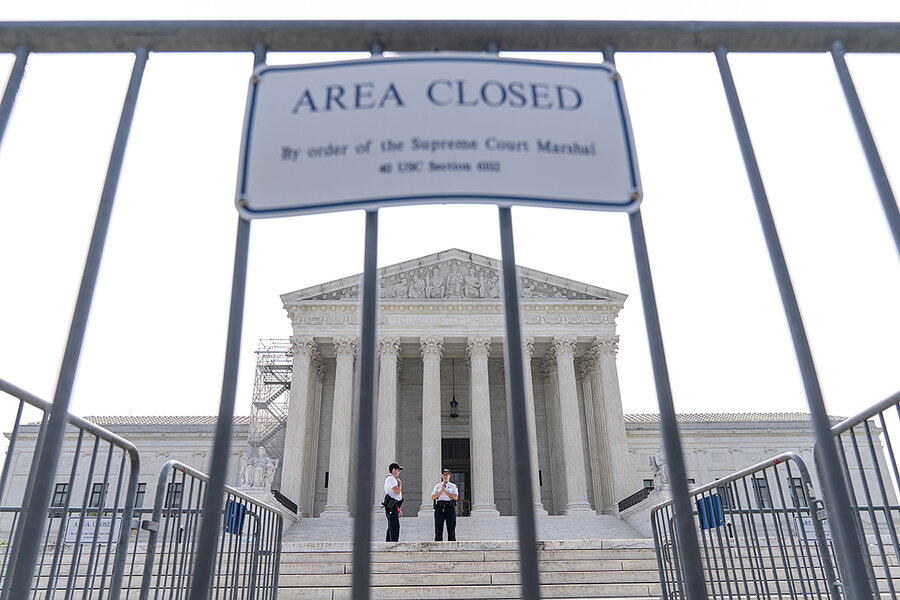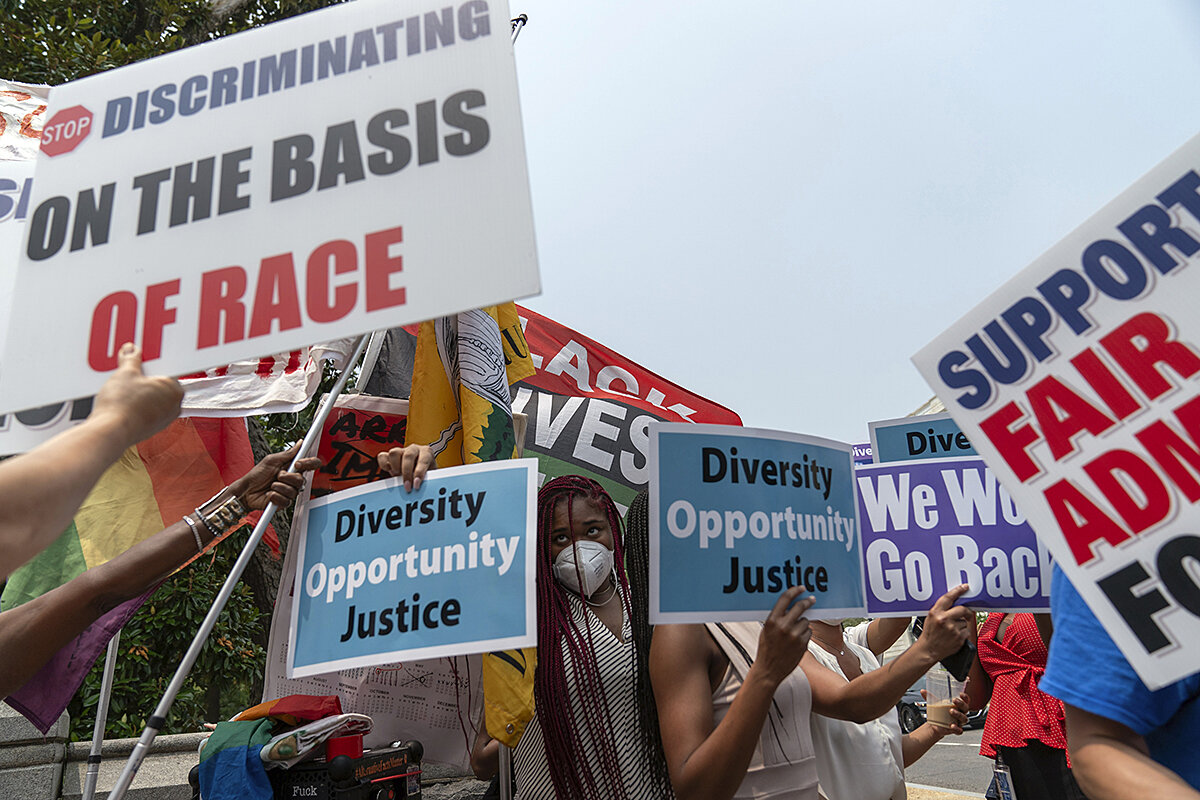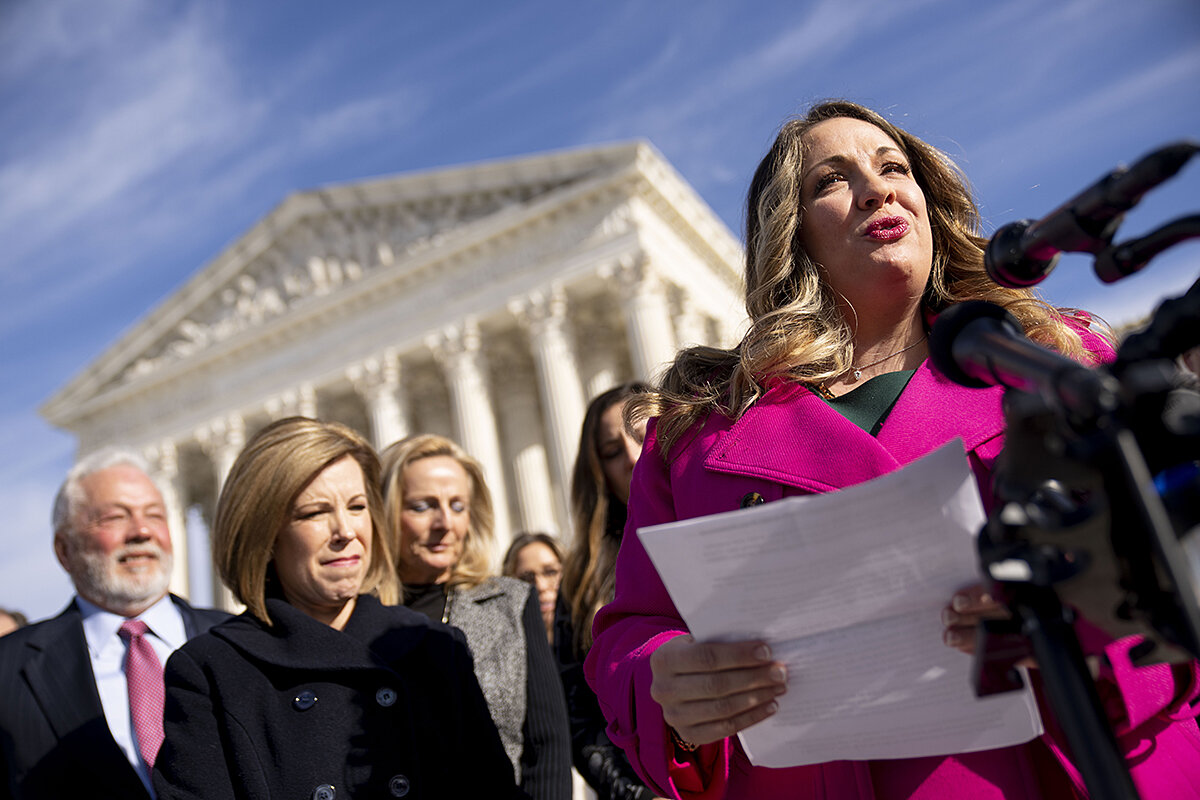The legal principle behind a more restrained Supreme Court term
Loading...
It is the first question that must be answered in every U.S. Supreme Court case: Does the court have jurisdiction to hear the case at all?
The question of standing, as it is called, loomed large over the just-concluded term in cases covering everything from immigration policy to student loans to Native adoption law.
Why We Wrote This
A story focused onThere were death threats, ethics scandals, and polls showing that Americans lost trust in the Supreme Court. But this term, the opinions themselves offered a return – in several cases – of more modest rulings and unwillingness to entertain controversial theories.
Standing doctrine, per the U.S. Constitution, limits federal court jurisdiction to certain “cases” and “controversies.”
If this seems vague – well, it’s something that even the justices have criticized as easy to manipulate.
While not as historic, or divisive, as the term before it – which included decisions overturning the constitutional right to abortion and expanding gun rights – the conservative court still reshaped the law in significant ways. But this most recent term has shown that, in some cases, the high court is only willing to go so far. Some cases involving more radical arguments and theories failed. Notably, the court upheld a key provision of the Voting Rights Act and threw out a controversial legal theory that would have given state legislatures sole authority over federal elections. Both decisions were hailed by election experts as strengthening democracy.
This term’s opinions themselves were – with several key exceptions – less likely to rely on the raw power of the supermajority. Last term, there were 14 decisions split 6-3 on partisan lines. This term, there were five.
It is the first question that must be answered in every U.S. Supreme Court case: Does the court have jurisdiction to hear the case at all?
The question of standing, as it is called, loomed large over the just-concluded term in cases covering everything from immigration policy to student loans to Native adoption law.
Standing doctrine, per the U.S. Constitution, limits federal court jurisdiction to certain “cases” and “controversies.”
Why We Wrote This
A story focused onThere were death threats, ethics scandals, and polls showing that Americans lost trust in the Supreme Court. But this term, the opinions themselves offered a return – in several cases – of more modest rulings and unwillingness to entertain controversial theories.
If this seems vague – well, not even the nine justices always agree, especially when it comes to cases brought by states against the White House. And it’s something that even the justices have criticized as easy to manipulate.
In 2007, for example, Chief Justice John Roberts wrote in a dissent that the special consideration for states was emblematic of “how utterly manipulable [standing doctrine is] if not taken seriously as a matter of judicial self-restraint.”
Last week, in her dissent in the student loan ruling, Justice Elena Kagan quoted that line back to him. “After today,” she wrote, “no one will have to go back 50 years for the classic case of the Court manipulating standing doctrine.”
While not as historic, or divisive, as the term before it – which included decisions overturning the constitutional right to abortion and expanding gun rights – the deeply conservative court still reshaped the law in significant ways this year. But this most recent term has shown that, in some cases, the high court is only willing to go so far. Some cases involving more radical arguments and theories failed. Notably, the court upheld a key provision of the Voting Rights Act and threw out a controversial legal theory that would have given state legislatures sole authority over how federal elections are run. Both decisions were hailed by election experts as strengthening democracy.
In other cases, the justices sought narrower rulings – rather than sweeping outcomes – and they often did so on procedural, jurisdictional grounds.
“The federal courts are not supposed to have jurisdiction over policy disputes that are just purely policy disputes,” says Carolyn Shapiro, a professor at the Chicago-Kent College of Law.
The Supreme Court, she adds – in this term and past terms – “has not been entirely consistent” on that point.
The return to restraint comes after last term’s ruling overturning Roe v. Wade brought with it protests, death threats, and polls showing record low trust in the high court. It also comes after ethics scandals embroiling several justices have renewed calls for the high court to adopt a judicial code of ethics. But this term’s opinions themselves were – with several key exceptions, including overturning affirmative action and allowing creative businesses to deny service to LGBTQ+ Americans – less likely to rely on the raw power of the supermajority. Last term, there were 14 decisions split 6-3 on partisan lines. This term, there were five.
The student loan case
In recent decades, the Supreme Court has typically taken a strict view of standing. Two years ago, for example, the court significantly narrowed the doctrine in a case concerning when a privacy violation causes sufficient harm to confer standing.
“Federal courts do not possess a roving commission to publicly opine on every legal question,” wrote Justice Brett Kavanaugh in that opinion.
There have always been exceptions, however. One decision in particular this term, involving President Joe Biden’s student loan forgiveness program, provoked a fiery standing debate.
Two cases challenging the program reached the court, one brought by individual borrowers and one brought by a group of Republican-led states. The court ruled unanimously that the individual borrowers, who hadn’t qualified for maximum relief, lacked standing. In the case brought by the states, Missouri argued that because an independent loan servicing agency it created would be financially harmed by the plan, the state itself was harmed.
While it was created by the Missouri government, the agency operates independently. It had the power to sue the Biden administration itself but chose not to – in fact, it declined to even file a brief in the case. Missouri had never before filed a suit on behalf of the agency, and any revenue loss the agency would suffer because of the loan relief program would not be passed on to the state.
“Not even Missouri, and not even the majority, claims that [the agency’s] revenue loss gets passed through to the State,” wrote Justice Kagan in her dissent.
“A bedrock principle of standing law [is] that a plaintiff cannot ride on someone else’s injury. Missouri is doing just that,” she added. “That means the Court, by deciding this case, exercises authority it does not have. It violates the Constitution.”
Chief Justice Roberts – the author of the 6-3 majority opinion and a justice with some of the court’s strictest views on standing – took umbrage at the criticism. The standing analysis was simple, he wrote. Because the agency suffered a concrete harm from the program (revenue loss) and because the state “created and controls” the agency, the state also suffered a concrete harm.
Several other standing decisions this term, however, came out against the interests of conservative plaintiffs.
Most prominently, the Supreme Court ruled 8-1 that Texas and Louisiana didn’t have standing to challenge Biden administration guidelines on immigration enforcement. Texas had argued that the guidelines prioritizing the arrest and removal of the most dangerous immigrants financially harmed the state. Accepting that argument would create a dangerous new standard, wrote Justice Kavanaugh in the majority opinion.
“The States have brought an extraordinarily unusual lawsuit,” he added. They “want the Federal Judiciary to order the [administration] to alter its arrest policy so that [it] arrests more noncitizens.”
“If the Court green-lighted this suit, we could anticipate complaints in future years about alleged Executive Branch under-enforcement of any similarly worded laws,” he continued. “We decline.”
In that sense, the term featured the return of an older Roberts court trend: deciding potentially sweeping cases on narrow grounds.
“This effort to postpone deciding certain questions, deciding certain cases narrowly, that’s something we haven’t really seen” for a few years, says Jonathan Adler, a professor at Case Western Reserve University School of Law.
That isn’t to say that the current Supreme Court isn’t deeply conservative, but it does mean it seems unwilling “to change [the law] dramatically without a full sense of what that entails,” adds Professor Adler. “That leads then to some of the more, I wouldn’t say moderate, but more modest and narrow decisions.”
Why standing matters
Since the standing doctrine is a procedural one, it may lack the glamour of meaty merits questions. But it’s arguable that no doctrine is more important to the court as an institution, and to the federal judiciary as a whole.
Standing jurisprudence informs what cases the courts can hear, which has ripple effects on the powers of Congress and the presidency. And that jurisprudence is determined exclusively by the judiciary itself. These case-by-case decisions also tend to be very fact-based and subjective.
“It gives lower courts, and particularly the Supreme Court, a lot of leeway to say, ‘We do want to hear this type of claim, so it doesn’t cross the line,’ or ‘We don’t want to hear this type of claim, so it does cross the line,’” says Scott Anderson, a visiting fellow at the Brookings Institution and an expert on standing.
Even when the high court rejects a claim on standing grounds, it can detail how similar claims could be successful in the future. This term, Justice Kavanaugh – another proponent of a strict standing doctrine – took on that role.
In one notable decision, the Supreme Court upheld a federal law governing the adoption of Native American children, holding that the parties didn’t have standing to challenge the law’s constitutionality. But in a solo concurrence, Justice Kavanaugh outlined how litigants might be able to achieve standing to bring such a constitutional challenge.
In his majority opinion in the immigration case, he also outlined how states could challenge other federal immigration policies, including the Obama-era Deferred Action for Childhood Arrivals program. And while a majority of the court upheld Section 2 of the Voting Rights Act in what may have been the biggest surprise of the term, Justice Kavanaugh outlined how states could challenge that key section in future.
These kinds of opinions offer guidance not just for prospective litigants, but for lower federal courts as well. When the Supreme Court rejects a standing claim, it’s also telling lower courts to reject that standing claim, says Professor Adler.
“It’s a way of imposing restraint on the judiciary as a whole,” he adds. “The tighter the [high] court is on standing, the more control it has on when it reaches these [merits] questions.”
The justices could tighten standing doctrine even more next term. The court will hear a case asking if a woman can sue a hotel for violating the Americans with Disabilities Act if she had no plans to stay there.
But another looming challenge for the court, previewed in this past term, is the combination of a more conservative federal judiciary and targeted lawsuits from conservative litigants bringing forth a steady stream of unusual legal arguments.
The “extraordinarily unusual” suit advanced in the immigration case had been approved by a District Court judge in southern Texas. Missouri’s controversial standing claim in the student loan case had been rejected by a District Court judge but endorsed by a panel of judges on the U.S. Court of Appeals for the 8th Circuit.
And in perhaps the highest-profile standing case of the term, the court stayed a ruling from a federal judge in northern Texas that would have restricted access to a widely prescribed abortion pill. That case has yet to reach the court for oral arguments.
In some of the court’s more controversial rulings – such as striking down affirmative action and allowing a website designer to not serve LGBTQ+ clients – standing was not an issue, says Professor Shapiro. The court is very conservative, and it can move the law in conservative directions without transforming standing doctrine. But its commitment to a narrow view of standing is likely to be tested, regularly, in the coming years.
“We will continue to see some really radical arguments take hold in some of the lower courts,” predicts Professor Shapiro.
“The fact the Supreme Court has so far rejected some of them doesn’t mean that it doesn’t push the law to the right,” she adds. The court “will probably accept some of them at some point, and it will consistently move the Overton window to the right on what arguments are acceptable.”










